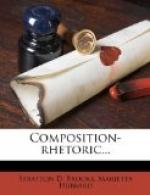The whistle is nearly finished. We have all seen him make them before and know what comes next. Our tongues seek over moist lips sympathetically, for we know the taste of peeled willow. He puts the end of the stick into his mouth and draws it in and out until it is thoroughly wet. Then he lifts the carefully guarded section of bark and slips it back into place, fitting the parts nicely together.
The willow whistle is finished. There remains but to try it. Will it go? Does he dare blow into it and risk our jeers if it is dumb?
With all the fine certainty of the Pied Piper the boy lifts the humble instrument to his lips. His eyes have a far-off look, his face changes; while we strain eyes and ears, he takes his own time. The silence is broken by a note, so soft, so tender, yet so weird and unlike other sounds! Our hands quiver, our hearts beat faster. It is as if the spirit of the willow tree had joined with the spirit of childhood in the natural song of earth.
It goes!
—Mary Rogers Miller: The Brook
Book.
(Copyright, 1902, Doubleday, Page and Co.)
+Theme XCIV.+—Write an exposition on one of the following subjects, making use of particulars or details:—
1. How ice cream is made.
2. The cultivation of rice.
3. Greek architecture.
4. How paper is made.
5. A tornado.
6. Description of a steam engine.
7. The circulatory system of a frog.
8. A western ranch.
9. Street furniture.
10. A street fair.
(Have you used particulars sufficient to make your meaning clear? Have you used any unnecessary particulars? Why is the arrangement of your topics easy in this theme?)
+169. Exposition by Cause and Effect.+—When our general statement is in the form of a cause or causes, the question naturally arises in our mind as to the effects resulting from those causes. In like manner, when the general statement takes the form of an effect, we want to know what the causes are that produce such an effect. From the very nature of exposition we may expect to find much of this kind of discourse relating to causes and effects. (See Section 49.)




